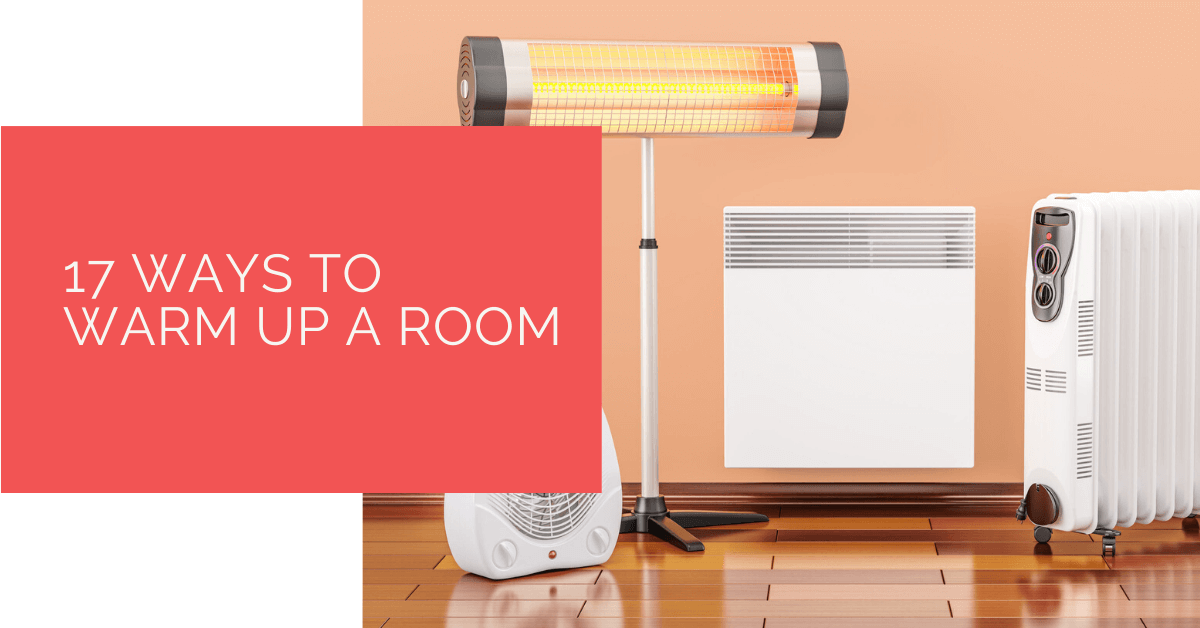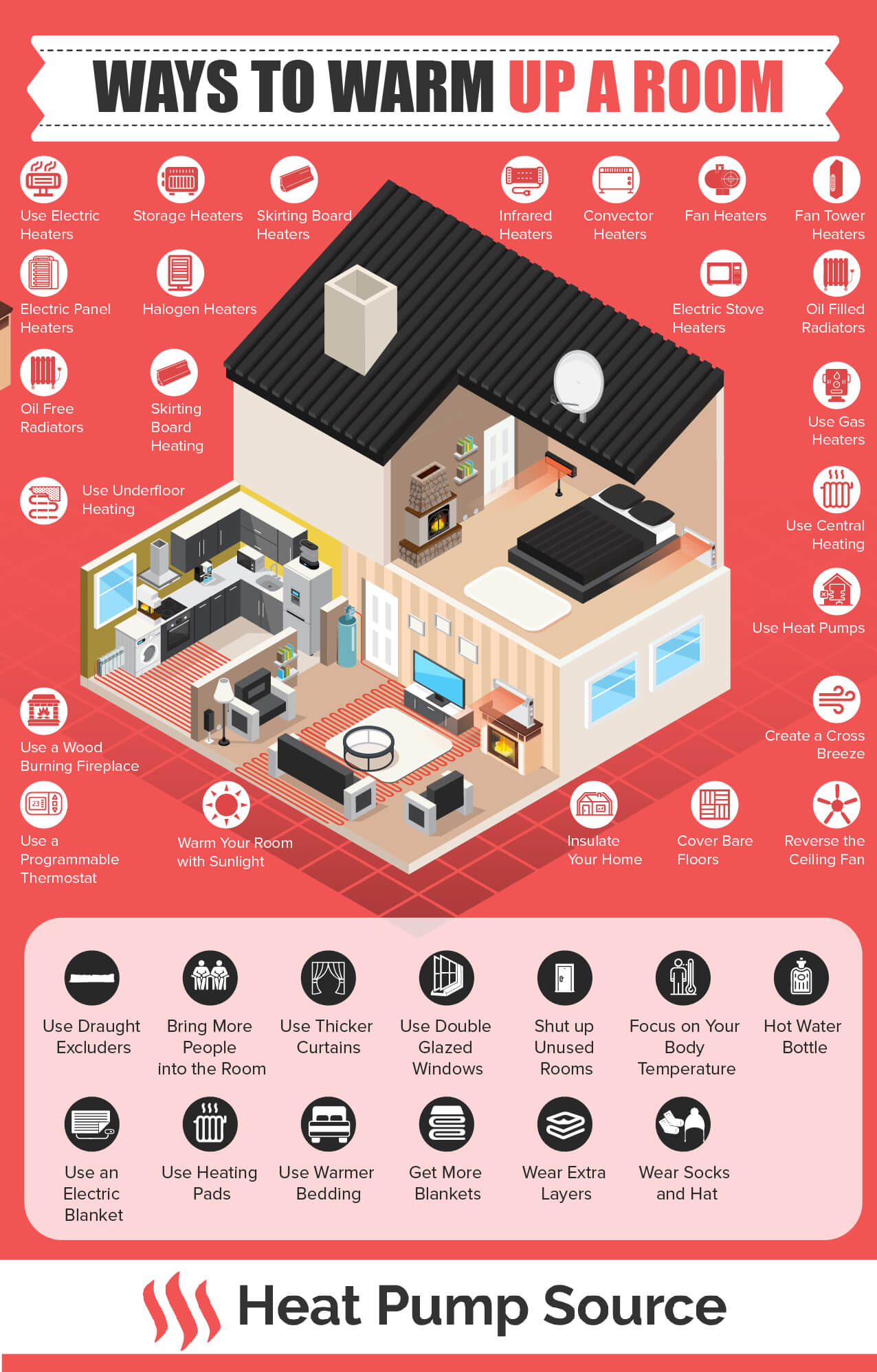Are you tired of a room that is always cold? Is your room always freezing? Thankfully, there are many ways to warm up your room quite easily. Here are 17 ways to quickly warm up a room fast and have a comfortable time inside your home.
Contents
- 1 Ways to Warm Up a Room
- 1.1 1. Use Electric Heaters
- 1.2 2. Use Gas Heaters
- 1.3 3. Use Central Heating
- 1.4 4. Use Heat Pumps
- 1.5 5. Use Underfloor Heating
- 1.6 6. Use a Wood Burning Fireplace
- 1.7 7. Use a Programmable Thermostat
- 1.8 8. Warm Your Room with Sunlight
- 1.9 9. Insulate Your Home
- 1.10 10. Cover the Bare Floors
- 1.11 11. Reverse the Ceiling Fan
- 1.12 12. Use Draught Excluders
- 1.13 13. Bring More People into the Room
- 1.14 14. Use Thicker Curtains
- 1.15 15. Use Double Glazed Windows
- 1.16 16. Shut up Unused Rooms
- 1.17 17. Focus on Your Body Temperature
- 2 Ways to Warm Up a Room Infographic
- 3 Heat Pump Source: Reliable Heating and Cooling Solutions
- 4 Conclusion
Ways to Warm Up a Room
1. Use Electric Heaters
Various types of electric heaters are available today at affordable prices. If you are looking for an electric heater, please check out our list and reviews of the best electric heaters available. Here are a few effective options:
Infrared Heaters
Infrared heaters provide heat by emitting infrared light. The biggest advantage of these heaters is that these directly warm up objects and bodies, and do not heat the air, which makes them much more energy-efficient as nothing goes to waste. These are also environmentally friendly.
Convector Heaters
Convector heaters have a unique method of dispersing air evenly and quickly and are a popular option for those who are looking to heat individual rooms.
Modern models of convector heaters come with some stylish designs, advanced safety features and multiple heat settings and even new technology called “forced convection”.
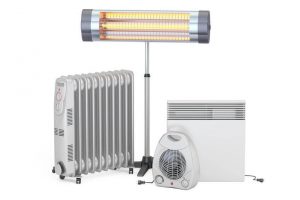
Fan Heaters
A fan heater includes a heating element and a fan which pushes air over the heating element. The air gets warmer when it passes over the heating element, and the fan pushes it out into the room leading to a warm room. It works quickly and efficiently.
Fan Tower Heaters
A fan tower heater is essentially a space heater that is designed for quick and efficient heating of large rooms.
It works similar to a fan heater mentioned above. An electric heater warms the surrounding air and the fan inside blows out this warm air while sucking in cold air.
The significant difference between a conventional space heater and a fan tower heater is that these tower heaters tend to be taller and are designed to warm up medium-sized rooms. The most significant advantage of using a fan tower heater is that these heat up much faster.
Electric Panel Heaters
An electric panel heater packs in a lot of power in a compact design. These are a great option for use in situations where you need instant heat as these quickly warm up the surrounding air. These are an excellent choice for smaller rooms.
Halogen Heaters
A halogen heater is an electric space heater that glows. One of the most common misconceptions associated with halogen heaters is that halogen is used as a heating element, but that is not true. The heating element is typically made of tungsten and halogen is the name used for gases that are used to increase the temperature and light output. These heaters produce near-infrared heat.
Electric Stove Heaters
An electric stove heater is an efficient and cost-effective portable heating solution. These are typically designed to be used as a supplemental heating source. These are designed to look like an elegant fireplace stove but use electricity to warm up air through convection. These models typically feature an adjustable thermostat and realistic flame effect.
Storage Heaters
These heaters are designed to store energy which is then released in the form of heat to keep a room warm. These are great for people who typically pay a cheaper rate for electricity in the night. There are ceramic bricks inside the heater that get warm and release the heat at the required time. It is an excellent way for you to take advantage of cheap electricity tariffs at night.
The biggest advantage of these storage heaters is that these are economical to run as compared to other options. The modern models available today come equipped with thermostats, fans and programmable timers allowing complete control over the release of heat.
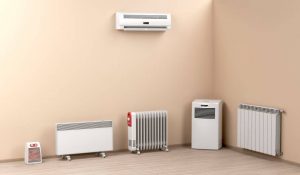
Skirting Board Heaters
Skirting board heating is similar in looks to traditional skirting boards. It is fitted with a heating system inside. You have the option of investing in a dry or a wet system. One of the biggest advantages of skirting board heaters is that these heat up very quickly and evenly distribute heat around the room. These are also energy-efficient. There are also portable skirting board heaters that can be easily moved from one room to another.
Oil Filled Radiators
Oil-filled radiators are an excellent solution for quickly heating a room. There are some incredibly designed and powerful options available, and with advances in technology and manufacturing processes, oil-filled radiators haven’t been left behind.
Oil Free Radiators
Oil free radiators have been designed to be more efficient, simpler to run, and much safer. And unlike the traditional oil-filled radiator, the oil-free heater heats up quickly and disperse the heat produced equally quickly.
2. Use Gas Heaters
A portable gas heater is essentially a space heater that makes use of natural gas or LPG to heat a room. Different types of gas heaters are available today. These are entirely safe to use when used as instructed and maintained correctly.
Keep in mind that gas heaters designed for outdoor use should never be used inside a room as it is not safe to use these indoors. Therefore, only use gas heaters that have been specifically designed for indoor use.
These heaters use a radiant method of heating to warm the air inside a room.
3. Use Central Heating
A central heating system distributes heat throughout your home typically with the help of hot water flowing in pipes and radiators connected to a boiler. These are typically gas-powered, and almost 95% of households in the UK have central heating.
However, these heat the whole house instead of warming up a particular room. If you do not want to heat your entire home to save some money on energy costs, it is better to utilise one of the above-mentioned options to warm up a room.
4. Use Heat Pumps
Heat pumps have become a popular alternative to using fossil fuels for heating your home. A typical heat pump works by transferring heat from one source to another location. These are highly energy-efficient as compared to other options. Different types of heat pumps are available today in various price ranges.
5. Use Underfloor Heating
Underfloor heating is an extremely versatile system as it works with the existing heating system in your home. In this system, warm water is circulated in the pipes that are fitted underneath the floor. It creates a vast radiant surface that warms up an enclosed space from the floor upwards.
The radiant form of heating is much more comfortable to convection heating. Also, it is much more energy effective as compared to the heat sources that use convection form of heating.

6. Use a Wood Burning Fireplace
A wood-burning fireplace is also an excellent heat source for quickly warming up a room. One of the most significant advantages of using a fireplace is that it keeps the room warmer for a long time and log burning fireplaces are available at affordable prices.
7. Use a Programmable Thermostat
An adjustable smart programmable thermostat works by switching on the heating when it senses that the air temperature in the room has fallen below the thermostat setting or your heating can be programmed to switch on a specific time of day. It switches off the heating when it reaches a pre-set temperature.
However, it is important to position it correctly. Make sure there is a free flow of air to the thermostat to sense the temperature inside the room accurately. It should not be blocked by furniture or covered by curtains. Also, it should be away from table lamps, TVs or electric fires.
8. Warm Your Room with Sunlight
Use sunlight to warm your room. Open up the blinds/curtains to let in as much sunlight as possible into your room. Make sure all the windows are closed when you leave in the morning, but all the blinds/curtains should be open.
Close the blinds when the sun stops shining and keep the blinds/curtains closed throughout the night to preserve the heat inside your room.
9. Insulate Your Home
Make sure your home is adequately insulated to prevent the warm air inside from escaping. Add insulation to the walls and windows, especially if you have an older home.
10. Cover the Bare Floors
If there are floors in your home without carpeting or rugs, use blankets, rugs or carpets to cover it. Almost 10% of the heat inside a room can escape through bare floors. So, use any of these solutions to cover the floors and to keep the heat from escaping.
11. Reverse the Ceiling Fan
You can save almost 10% on your heating costs by running your ceiling fans in reverse during the winter months. In the winter months, the hot air in your room rises to the ceiling, which means the cold air sinks. When you reverse the ceiling fan, the cool air is drawn upwards, and it forces the warm air back down, which keeps you comfortable.

12. Use Draught Excluders
If there are spots in the room where cool air can leak in, use draught excluders to plug these gaps. Draught excluders are available in a wide variety of styles, and these are specifically designed to plug in any leaks happening through the windows or doors.
13. Bring More People into the Room
Human beings are an excellent source of heat. If possible, bring a few more people into your room, and their body heat will noticeably warm up the room in no time. Also, it will help if they are more physically active.
14. Use Thicker Curtains
As mentioned in the above paragraphs, one of the most frequent sources of heat loss in a room is windows. To prevent this heat loss, put thicker curtains around the windows and close the curtains in the evening. If you do not want to invest in thicker curtains, get some old blankets and hang them in front of your windows.
15. Use Double Glazed Windows
Double glazed windows are much more efficient at preventing heat loss. These do cost a bit extra as compared to single-pane windows but allow you to retain heat inside a room for much longer.
16. Shut up Unused Rooms
If you have unused rooms in your house, closing the doors and vents for central heating might seem like a good idea, but it can put additional stress on your heating system.
17. Focus on Your Body Temperature
Hot Water Bottle
One of the best ways to avoid a freezing bed is to tuck in a hot water bottle in your bed under the covers just 15 minutes before you go in. It will leave your bed nice and toasty and keep you comfortable. These do not cost much.
Use an Electric Blanket
Investing in an electric blanket will allow you to remain comfortable in your bed inside a cold room. Also, these are much more energy-efficient as compared to heaters. Do not forget to start your electric blanket a few minutes before getting into the bed.
Use Heating Pads
You can also use heating pads to warm your bed to get relief from the cold inside the room. While these are available at affordable prices, you can also make them at home.
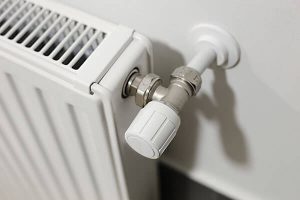
Use Warmer Bedding
One of the ways to warm your bed is to take a hairdryer and blow hot air directly onto the bed to create warm bedding. Keep the hairdryer at a safe distance from your bed.
Get More Blankets
If you are still feeling cold inside your room, get more blankets. The air pockets created by using multiple brackets prevent heat from escaping and allows you to remain comfortable in your bed.
Wear Extra Layers
One of the ways for you to stay warm inside your room without spending money on an external source of heating is to wear layers at night. If you do not feel uncomfortable, wear clothes made from rayon, polyester or other fabrics that do not breathe as these are excellent at trapping heat.
Wear Socks and Hat
Your head and feet let heat escape faster compared to the rest of your body. Cover these with socks and a hat to preserve your body heat and remain warm inside your room.
Ways to Warm Up a Room Infographic
(Click infographic to enlarge.)
Heat Pump Source: Reliable Heating and Cooling Solutions
At Heat Pump Source, we take pride in our unwavering commitment to serving the UK with top-tier HVAC solutions. From the efficiency of heat pumps and the cool relief of air conditioning to the warmth of boilers, radiators, and underfloor heating, our dedicated team is always at the forefront of innovation. We understand the unique needs of every household and business, and we strive to provide dependable health and cooling products and services that are tailored just for you. Ensuring your comfort and satisfaction is our utmost priority. Whether you have questions, need guidance, or require support, we’re always here to assist. Please don’t hesitate to contact us; we’re eager to be of service.
Conclusion
It can be challenging to stay warm in the winter months, but using the solutions mentioned above will allow you to keep your room warm with little effort.
While some of these tips require you to spend a bit of money, there are also a few cheaper or free alternatives.
Keep a positive attitude and use the tips mentioned above to remain comfortable and toasty during the winter months.
About the Author
At Heat Pump Source, our articles are the product of a collaborative effort among a team of highly skilled HVAC experts. Our dedicated professionals, hailing from diverse backgrounds in heating, ventilation, air conditioning, and refrigeration, contribute their extensive knowledge and experience to every piece of content. This multidisciplinary approach ensures comprehensive coverage. Our commitment is to deliver authoritative, reliable, and tailored advice to meet the unique needs of every household and business across the UK.

